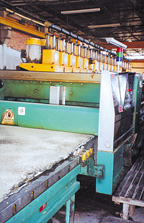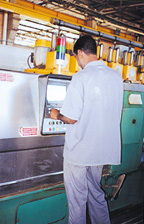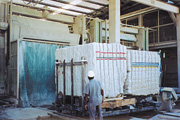

The most recent investments in the plant, which spans across an area of 54,000 square feet, have totaled over $3.5 million.

Slab fabrication
For processing blocks into slabs, equipment includes five Gaspari Menotti Model Alicone 490 gangsaws. Blocks are processed into 3-cm-thick slabs for the U.S. market, and into 2-cm-thick slabs for other markets.After being processed into rough slabs, the material is sent to one of two Breton slab polishers, each of which have 19 heads. Each of the polished slabs are carefully checked for blemishes or imperfections, and any slab with a defect is re-polished. Prior to re-polishing, the surface of the slab is coated with wood shavings, which allow the polishing heads to fix the imperfections without losing excess surface material.
With the new equipment in place, production capacity is now 64,000 square meters of slabs per month. As an added measure of quality control after shipment, the sides of the slabs feature a color-coding pattern that denotes the lot and sequencing of the material. This way, if there is a problem with a slab, the customer and the company can quickly determine exactly where and when the stone was quarried and fabricated.

Tile fabrication
For processing blocks into tiles, fabrication starts with one of two Gaspari Menotti Model Alicone 350 gangsaws. These machines cut the material into 1-cm-thick slabs.After slabbing, the material moves to a Breton tile line. The first piece of equipment on the line is a crosscutting machine with seven cutting heads. The resulting strips are then calibrated, and a conveyor delivers them the second half of the line, which features a 14-head polishing line and a second crosscutting machine. This multi-head saw, which has 11 cutting units, makes the final cuts of the strips to produce tiles.
The edges of the tiles are then beveled, and the tiles are dried before final inspection. After inspection, the tiles are stacked, boxed and palletized. Production of tiles stands at 20,000 square meters per month.
In addition to slabs and tiles, the Cachoeiro factory fabricates stone for architectural projects. For this work, the company features advanced machinery such as a Contourbreton NC 120 numerically controlled stoneworking center for cut-to-size pieces and a Comandulli edging machine. Marbrasa has also created a technical department, which works on AutoCAD, for custom projects.
Marbrasa's finished products have been used on projects in Italy, Spain, Portugal, the U.S., Canada, the Middle East and several other countries. Approximately 40 to 50% of the company's production is exported, with 80% of the exports being shipped to the U.S. In a recent project, the company supplied 3,000 vanities for the Aladdin Hotel and Casino in Las Vegas.